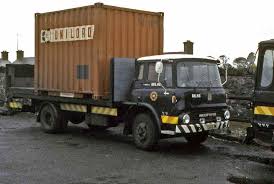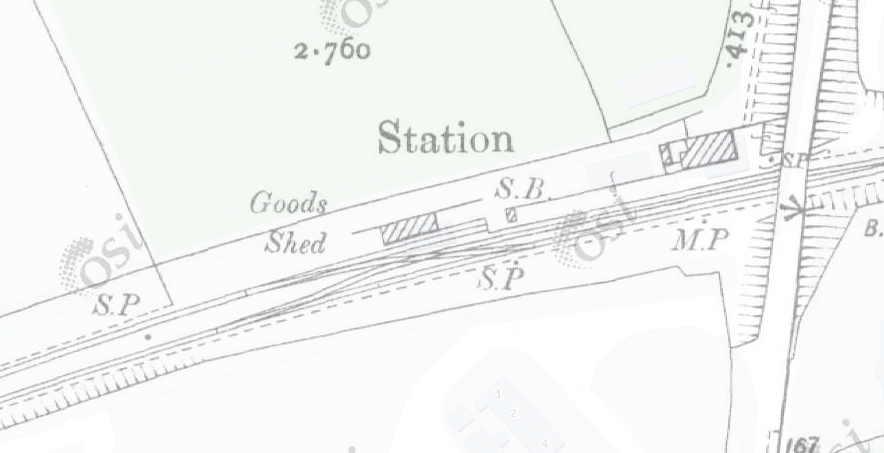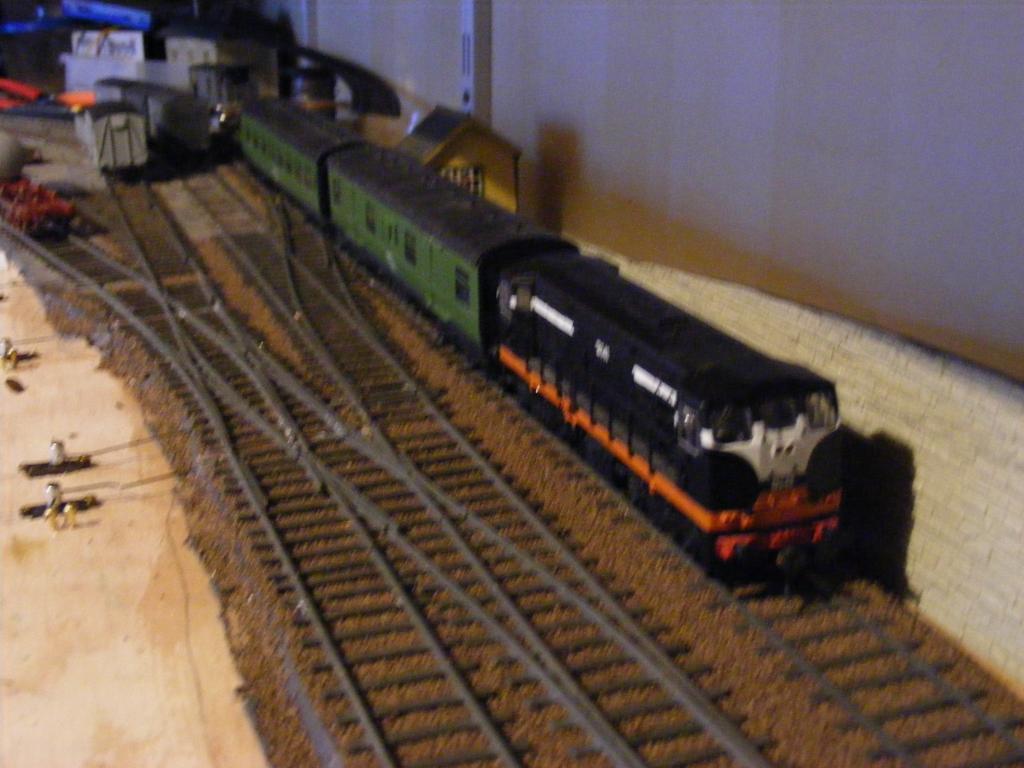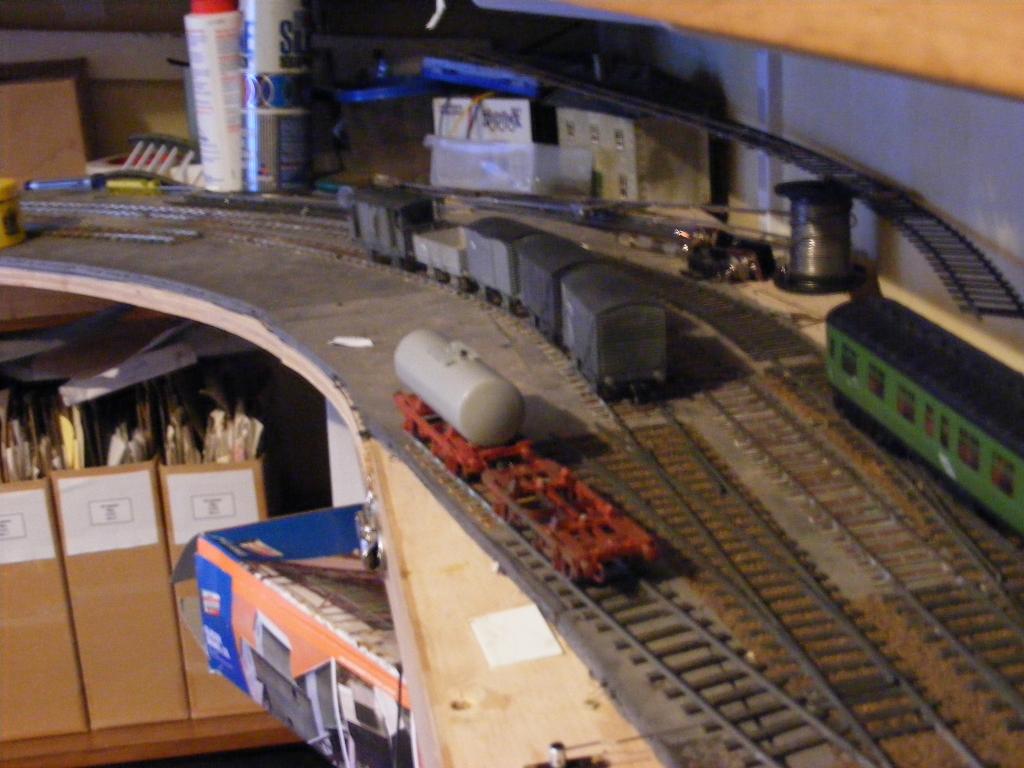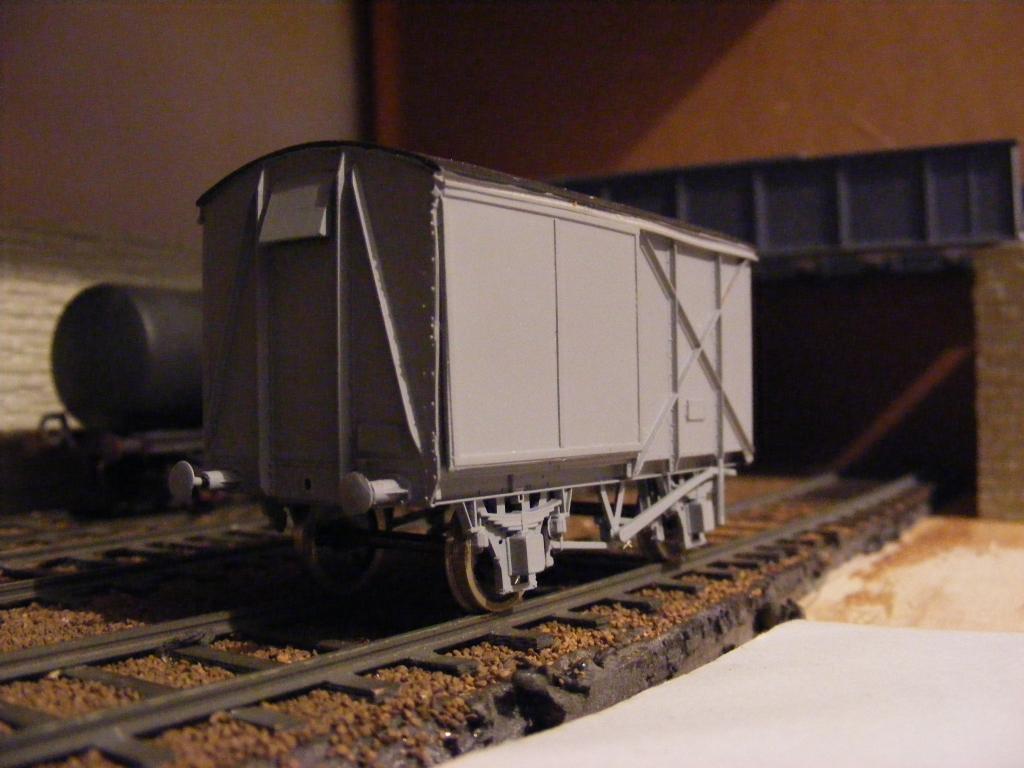-
Posts
4,730 -
Joined
-
Last visited
-
Days Won
117
Content Type
Profiles
Forums
Resource Library
Events
Gallery
Blogs
Store
Community Map
Everything posted by Mayner
-

where can I visit and photo a real bullied single sided beet wagon
Mayner replied to Junctionmad's question in Questions & Answers
The black running gear looks even better . It might calm down once the paint starts to fade, Some friends had "BR Bauxite" specially formulated for a narrow gauge brake van in the UK. The van eventually faded from a salmon pink when freshly painted to a much darker shade -
The side door containers seem to have been used as a more modern substitute for H vans rather than for intermodal work before loose coupled goods trains were phased out in the late 70s I remember seeing side door containers and half heights in traffic use in the down goods yard in Athy around 78, there are a number of photos of side door containers in the Youghal goods train.
-
An alternative is to use Marcway copper clad pointwork in combination with their SMP plastic sleepered flexible track. http://www.marcway.net/point.php. Marcway will also produce custom pointwork and complex formations in addition to their standard range of points and crossings. This might have an advantage over using standard points with the curved track formations in Omagh Goods yard, David Holman used custom built Marcway points and trackwork for his Arigna Town broad gauge O Scale layout. One of the advantages of thin sleepered systems like Marcway/SMP is that its a lot simpler to ballast the track than with Peco or other systems with thuck sleepers. Basically lay the track on a thin layer of PVA or School Glue applied to the track underlay and simply sprinkle the ballast on top and vacuum off the surplus after 15-20 minutes.
-
Hi Tony Personally I would not fit polythene as a vapor barrier between the framing and Stirling Board as its likely to trap air moisture breath and environmental) inside your shed and potentially increase rather than decrease the risk of molds and damp inside your shed. In recent years building design has shifted away from vapor barriers towards building wraps such as Du-Pont Tyvek or bitumen based "building paper" that allow airborne moisture to enter and leave a building following problems with leaky homes in North America and New Zealand. The Stirling Board and roofing felt will serve a similar function to a building wrap. I would strongly recommend insulating the ceiling and laying polythene on the ground underneath the floor. The polythene will prevent moisture from beneath the floor approx 3ltr a day for a 9Sqm shed https://www.standards.govt.nz/touchstone/building/2014/jul/preventing-dampness-under-suspended-floors/ I live in a 1920s renovated bungalow of timber frame with weatherboard wall cladding and a corrugated iron roof similar to your shed, with similar range of temperature and humidity to the West of Ireland. Although our walls are not insulated and no vapor barriers/building wraps used, mold and damp is not an issue 1. the important thing is to ensure adequate ventilation at eaves level by leaving a gap between the top of the insulation and the underside of the roofing felt at eaves level. 2. Ensuring that the temperature inside the shed does not fall below dew point. I have an electric radiator with the thermostat set at the minimal setting in my garden shed/workshop which is of similar construction, and have had no problems with moisture damage to tools rolling stock or electronic equipment Gyproc Thermaline http://www.british-gypsum.com/products/gyproc-thermaline-pir?tab0=0 or a similar insulated plasterboard is probably the simplest and most economic way of insulating the ceiling in your shed.
-
Leslie: Hope you follow this up with a model of the ubiquitous 10' Uniload container that were used to carry the bulk of sundries traffic between the late 70s & early 1990s. Most sundries traffic was carried carried in these wagons with door to door delivery by Bedford TK fitted with taillift. Sundries high value goods like cigarettes, spirits, motor parts were packed into caged trollies at the factory or railhead then placed inside the 10' containers,
-
In a way space is less of a problem in modelling an old style goods yard than a passenger station, with minimalist scenery and no station platforms you can fill most of the baseboard with track. Canada Road http://www.emgauge70s.co.uk/layout_alloa.html is an inspiration for what can be achieved in a small space.
-
Hi Kevin JM Design and railway modelling has had to take a back seat for most of 2017 due to family and other work commitments, at this stage I am unlikely to be able to fill orders for coach sides or release further kits before Jan 2018. If all goes well I may have more time in 2018 and possibly manage a visit to Ireland/
-
The operational & signalling side of the County Down was placed under GNR "supervision" following the Ballymacarrett Collision in 1945 when a Hollywood-Belfast push pull train ran into the back of a stationary Bangor-Belfast train as a result of which 22 people died and 27 were injured https://en.wikipedia.org/wiki/Ballymacarrett_rail_crash. Steam push pull workings were abolished and GNR double ended Atkinson Walker railcars operated the shuttles following the accident. The collision may have been one of the main catalysts for setting up the UTA as the collision had effectively bankcupted the County Down
-
Building the layout in OO opens up the option of using modified British RTR locos rather than scratch or kit building GNR prototypes. In the past the GMR/Airfix 4F modified with a round top firebox and canopy cab was used as a basis for the SG Class 0-6-0. Both Hornby & Bachmann produce a 4F, the Hornby loco is based on the 30 year old Airfix tooling complete with tender drive, while the Bachmann loco is more recent with the motor in the loco. http://www.hattons.co.uk/52563/Bachmann_Branchline_31_882_Class_4F_0_6_0_43924_BR_black_with_late_crest_and_Fowler_tender_as_preserved_/StockDetail.aspx Likewise it might the Hornby T9 with a new cab & 6 wheel tender could be used as a basis for an S Class. Allow a year and a budget of £250 per loco if you decide to build from scratch or assemble a loco from a kit. Worsley Works produce scratchbuilder parts for the GNR U & UG locos and underframes sides and ends for AEC & BUT railcars and a number of different coach types. SSM produce kits for the AL 0-6-0, PPs 4-4-0, S & SG Class, K15 & L12 coaches & the 30T goods brake
-
The driver who was trapped in last years quake drivesthe 1st Southbound revenue earning freight from Picton into Christchurch since the quake ehttp://www.nzherald.co.nz/nz/news/article.cfm?c_id=1&objectid=11922829. The first through Northbound freight ran through yesterday with traffic for the North Island and wagons for repair in Hutt Works outside Wellington. Engineer Sullivan's train started its journey departing Westfield Yard Auckland on Wednesday evening with traffic for Bascik, Toll Group, Mainfreight, Owens Transport, Daily Freight and Maersk bound for Wellington & the Cook Straight Train Ferry & the MLN to Christchurch.
-
Going off topic both Ferbane and Belmont & Cloghran on the Banagher branch had track layouts with the goods yard served by a crossover off the goods loop and a diamond crossing across the running line up to closure in 1963. Presumably this saved a facing point lock and made shunting quite interesting. Smaller stations on the North Kerry & Limerick-Sligo line tended to have a similar track layout without the complication of the diamond crossing, this would have simplified attaching and detaching tail traffic to passenger and mixed trains.
-
Not really a realistic comparison the Main Line North is an important freight route the earthquake and line closure had a $40m cost effect on Kiwirail, IE/CIE have been trying to persuade the Government to let it close the Nenagh line with out success for the last 40 years. Logistics companies that use rail for long distance line haul work between the North Island and Christchurch such as Mainfreight & Toll NZ are likely to have applied pressure on the government to re-build the line.
-
Through Wellington (Picton)-Christchurch freight services to resume on 15th September 10 months after the Nov 2016 earthquake. http://www.kiwirail.co.nz/news/497/78/First-post-quake-freight-services-announced/d,news.html
-
My failure to get to grips with building a 21mm gauge layout in 20 years is more to do with external factors and personality than the challenges of scratch and kit building in 21mm gauge. Although my primary modelling interest is the Irish broad gauge I have tended to focus more on building locos and stock in 4mm to 5'3" and the 3' gauge than building a layout as until recently I did not have a suitable space. I have a shortish span of attention and tend to have flirtations in various scales and gauges and over the past 30 years built American N & G Scale, an Irish 3' shelf layout and an EM gauge industrial layout. Apart from the N Gauge all layouts have had spurts of interest followed by long periods of inactivity. Re-gauging a Murphy Models B141 and some Irish Railway Models ballast wagons or Cement Bubbles to 21mm gauge either to EM or S4 standards using Ultrascale or Gibson wheel sets would probably be the simplest way of getting something running before making a final decision between handlaying track in 21mmm gauge or continuing in OO, while gaining experience in kit and scratch building rolling stock.
-
In practice using EM gauge wheel sets in 21mm gauge does not have a significant distorting effect on the width of 21mm gauge locos and rolling stock. The overall wheels set width is 0.06 mm wider or ¾" in full size terms using EM rather than S4 wheel sets. The wider 2.28-2.3mm tyre width is largely offset by the narrower back to back gauge of 19.5mm used with modern plastic centered Gibson and Ultrascale wheels, some modelers use "standard" Jackson, Hornby, Bachmann wheels with a back to back of 19.3mm. The looser running tolerance using EM/OO standards is more forgiving in terms of workmanship building trackwork and rolling stock and to run locos and stock round smaller radius curves than feasible in S4 Its important to consider that its not always practicable to scale down running clearances between driving wheels and splashers and between rods in valve gear and that it may be necessary to increase clearances even in S4 standards. SSM locos have been built to 21mm gauge to EM standards by a number of modellers including several J15, S Class 4-4-0s and a number of SG 0-6-0s without significant modification, though it is important to check that there is sufficient clearance behind valance and splashers regardless of whether a loco is being built to 21mm or S4 standards
-
I have been messing around in 21mm gauge for over 20 years to EM standards though I have yet to build a successful layout mainly due to the lack of suitable space to build a layout. I started building an 8'X6' shunting layout a few years ago but gave up because because of side-swipe between coaches as I did not allow enough space between lines on curves, min radius curve was 3'. Track and back to back gauges were sourced from TMD models (the precursor of SSM) many years ago. At one stage SSM also produced 28mm W Irons for 21mm gauge stock and single lever IRCH brake gear used by the GNR and the Southern companies. 21mm loco & wagon/coach wheel sets were sourced from Ultrascale (Gear Services Letchworth) or by cutting and sleeving standard 26mm OO/EM gauge axles with 2mm bore brass tube, more recently I have used locally sourced 28mm Sn3.5 axles from Northyard Models. Ultrascale though expensive is probably the best option in terms of quality, though steam loco driving wheels are largely restricted to GWR types and there is a 3 month lead time between placing and filling an order. Alan Gibson produces a large range of wheels and components including brass wire, handrail knobs, bearings, though availability is somewhat patchy. High Level Models produce a range of gearbpxes which have become the de-facto standard for 4mm kit and scratch built locos. If you are going down the road of modelling the Omagh in the 1950s or 60s there is no real alternative to scratch or kit building every item of rolling stock. If you choose to use Murphy Models Irish coaches or other rtr OO gauge stock you will need to widen or replace the bogies/underframes as they are too narrow for 21mm gauge wheelsets. Murphy Models 141 with SSM Bredin Coaches Dapol & Parkside wagons with widened underframes I did not allow enough clearance between running lines and sidings which lead to side swiping between coaches on curved track CIE Palvan modified from Parkside BR van by moving out solebars and modifying doors
-
I would stick with OO or possibly N if you are planning to build a layout with a continuous run in a 10'X6' shed and you want to get something running quickly. I have been working in 21mm gauge for many years and simply haven;t had the time or space to build a layout. OO gauge rtr model steam locos are designed with considerable sideplay between wheels and chassis to reliably operate around curves of down to 15" radius. Handlaying track and building/converting rolling stock to 21mm gauge is straightforward enough provided you have a methodical approach and access to accurate track and back to back gauges. The minimum radius a loco or coach will traverse becomes a greater limiting factor the closer you get to the prototype in terms of wheel profile and gauge, which is one of the main reasons EM, P4 and 21mm layouts tend to be end to end or shunting planks rather than continuous run. 2' radius is the minimum recommended for a main line layout in OO- 3' about the minimum for a 4-4-0 tender loco in 21mm to OO/EM standards -3'6-4' in P4
-
Meanwhle in the UK the Department of Transport is planning to start trialing platoons of driverless trucks next year. https://www.engadget.com/2017/08/25/uk-platooning-trials/ Potentially major threat to workers whoes livliehoods are dependent on the trucking industry
-
Wagon load traffic was usually marshaled in station/yard order behind the locomotive. Its a lot easier and safer for a train crew to switch a single or a short cut of wagons than a whole train into a siding. This practice still continued to a lesser degree on railways that carry wagon load traffic, though traffic tends to be in cuts of wagons carrying a particular traffic than individual wagon loads The Sligo-Limerick goods would have run with wagons for stations on the Burma Road cut in behind the loco and traffic for destinations south of Claremorris including Bell containers for Waterford cut in behind the van. Depending on destination container wagons could also be cut in at the front or middle of a loose coupled goods. Before the Mayo Line went over to Liner operation wagons with ISO container traffic for Claremorris were likely to have been marshaled towards the middle of the train as the "Ballina Goods" departed the North Wall on its way westwards.
-
Welding the last rail joint to re-connect Christchurch & Picton 8 Aug 2017
-
I experimented with 3D printing for things like buffers, battery boxes and fuel tanks for the tin vans in Shapeways FUD. A high proportion of railway modelers produce the initial 3D model using the free basic version of sketchup or Autodesk 123D then upload the files to Shapeways who will produce a 3D render of your model and a quote for producing a model. Professional 3D modellers like B 1 Lancer & Neil Ward http://shpws.me/ONou have the advantage of high end professional design software like Solid Works Its definitely worth while having a play with Sketchup and uploading the results to Shapeways to get a feel for the 3D design and additive manufacturing process and the pros & cons of the whole process.
-

Photographic Website Updates
Mayner replied to thewanderer's topic in Photos & Videos of the Prototype
Quite a bit of change since visited Cobh by train in the mid 70s. The branch had quite an air of decay more in common with BR suburban and branch lines than CIE. The station building and Up Platform area was in use as a depot in connection with the Kinsale gas field, the up platform road and release road had been recently lifted and builders were building a concrete block wall between the depot and operating railway. The goods yard was still in use for block trains of scrap (mainly cars) in loose coupled corrugated opens, the carriage shed (Garda Station) was full of departmental coaches . A couple of years later the coaches had gone and the shed used to store empty open wagons. Off peak passenger services seemed to have been an hourly service with a B141 & 2-3 coaches with an extra train set during the morning an evening rush hour. Had a very exciting run over the line behind a 001 with 2 coaches in the mid 80s before the NIR railcars took over. Despite or maybe because of the 50mph line limit acceleration and the sound was phenomenal as the loco accelerated its featherweight train away from each intermediate stop. Maybe there is a case for Cork City Council to follow the example of Dunedin in New Zealand and establish a joint venture with IE & the RPSI to operate a shuttle service for cruise ship passengers between Cobh and Cork and excursions to Killarney. Dunedin bought a section of the closed Otago Central line from NZR in the late 1980s and set up a joint venture to operate the line as a commercial operation (not a heritage railway! )with a local enthusiasts group http://www.dunedinrailways.co.nz/our_company. Not as spectacular but an interesting parallel of what might have happened had Cork City or County Council had bought the Youghal Branch from CIE during the same era. -
I started studying the Triang-Hornby catalogue and picked out my 1st proper trainset a Triang-Hornby South African Goods in Terrys Toy Shop Henry Street when I was 12. During the summer holidays I explored the shops that stocked model railways eventually wearing a track through the city centre between Leeson Street and Monck place. Besides toy and hobby shops some bicycle/radio/tv shops stocked model railways including Mc Hugh Himself in Talbot Street, a radio/tv shop on Mary Street opposite the Jervis Centre, I came across a treasure trove of old Tri-ang track and accessories including Block Instruments in a shop at the corner of Grafton Street and St Stephens Green. My horizons widened as I got a bit older to include the Model Shop in Rathfarnham Shopping Centre and occasional visits to George Hannan's shop in Malahide. The shop in the Rathfarnham Shopping Centre was managed by John Byrne who commissioned the first Irish Lima rtr models. Declan Lonegan a talented modeler and former Secretary of the MRSI assisted in the Rathfarnham shop on Saturday afternoons, was very helpful and some times brought along models assembled from whitemetal kits including a GEM LNWR Jumbo 2-4-0 George Hannan was an accomplished Narrow Gauge modeler and artist, who's model of Killybegs was featured in the Railway Modeller during the early 60s also built a 009 rabbit layout with scratch built models of Welsh Narrow Gauge locos and stock. I went through much the same experience though I had deeper pockets when I moved to the UK in the mid-80 often spending my weekends for the first couple of years visiting model shops and exhibitions in London and the South East.
-
The trailer coach looks like a K15 3rd Class. SSM do a complete kit for these coaches, Worsley Works have the option of a set of scratch builders parts or sides only to fit a rtr body. Interesting the note about the coach being panneled in Tempered Masonite (compressed cardboard) on timber framing which contributed to the short life of post WW11 GNR coaches compared to similar NCC/UTA & CIE stock
-
Good news Kiwirail expects to re-open the line for through freight services "within weeks" approx 4 Months ahead of schedule with two overnight freights between Picton & Wellington 50% of the normal scheduled service. Its planned to run at night to avoid conflict with the earthquake recovery work, railway also expects to carry construction material for the re-build ttps://www.stuff.co.nz/timaru-herald/news/national/95374850/South-Island-rail-line-could-open-for-freight-within-the-month
.png.c363cdf5c3fb7955cd92a55eb6dbbae0.png)

